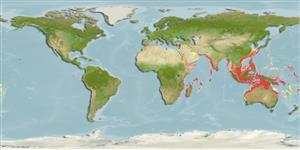sub class Elasmobranchii (ฉลามและกระเบน) (sharks and rays) >
Carcharhiniformes (Ground sharks) >
Carcharhinidae (Requiem sharks)
Etymology: Carcharhinus: karcharos (Gr.), sharp or jagged; rhinus, an ancient name for sharks, from rhine (Gr.), rasp, both words alluding to a shark's jagged, rasp-like skin. (See ETYFish); sorrah: Tamil (Indian subcontinent) word for shark [authorship often attributed to Müller & Henle, who published Valenciennes’ description]. (See ETYFish).
Environment: milieu / climate zone / depth range / distribution range
นิเวศวิทยา
เกี่ยวกับทะเล,น้ำเค็ม; กร่อย เกี่ยวกับหินโสโครก; ระดับความลึก 0 - 140 m (Ref. 30573), usually 1 - 73 m (Ref. 90102). Tropical; 31°N - 31°S
Indo-West Pacific: Persian Gulf (Ref. 68964), Red Sea and East Africa (including Madagascar, Mauritius and Seychelles) to the Philippines, north to China, south to Australia. Also from Vanikolo Island (Santa Cruz Islands) and the Solomon Islands. Possibly occurring in the Gulf of Aden, Gulf of Oman and Sri Lanka (Ref. 9997).
Length at first maturity / ขนาด / น้ำหนัก / Age
Maturity: Lm 130.0 range ? - ? cm
Max length : 160 cm TL เพศผู้/กระเทย; (Ref. 2334); น้ำหนักสูงสุดที่มีการรายงาน: 28.0 kg (Ref. 6390); อายุสูงสุดที่ได้รายงาน: 8 ปี (Ref. 6390)
เงี่ยงครีบหลัง (รวม): 0; ก้านครีบอ่อนที่หาง (รวม): 0; เงี่ยงครีบก้น 0; ก้านครีบอ่อนที่ก้น: 0. A small, spindle-shaped shark with a long, rounded snout, large circular eyes, and oblique-cusped serrated teeth; 2nd dorsal fin very low; interdorsal ridge present (Ref. 5578). 2nd dorsal, pectorals and lower caudal lobe with dark tips; 1st dorsal with thin but conspicuous dark tip; pelvic fins and upper caudal lobe plain (Ref. 5485). Grey or grey-brown above, white below with a golden-brown sheen on the area between eyes and gill slits (in fresh specimens); pectorals, second dorsal, and lower caudal fin lobe with conspicuous black tips, first dorsal and upper caudal fin lobe with black edging (Ref. 9997). A dark band on flank extending rearwards to pelvic fins (Ref. 9997).
Found on the continental and insular shelves, primarily near reefs (Ref. 244). Sometimes in offshore waters (Ref. 30573). Live near the seabed during the day and near the surface at night (Ref. 6390). Feeds on bony fishes (Ref. 68964). Shark movements often short (50 km) but may be more than 1,000 km (Ref. 6390). Prefers teleost fishes but also feeds on cephalopods and crustaceans (Ref. 6871). Viviparous (Ref. 50449). Regularly caught by local artisanal and small-scale commercial fisheries where it occurs (Ref. 244). Utilized as a food fish; fins used in the oriental shark fin trade, liver for vitamin oil, and offal for fishmeal (Ref. 9997).
Viviparous, with a yolk-sac placenta (Ref. 244). Pups, average 3, range 1-8, are produced in January after a 10-month gestation period. Average length at birth is 50 cm TL. Length increases by about 25 cm during the first year. These sharks breed once each year (Ref. 13440). Distinct pairing with embrace (Ref. 205).
Compagno, L.J.V., 1984. FAO Species Catalogue. Vol. 4. Sharks of the world. An annotated and illustrated catalogue of shark species known to date. Part 2 - Carcharhiniformes. FAO Fish. Synop. 125(4/2):251-655. Rome: FAO. (Ref. 244)
IUCN Red List Status (Ref. 130435)
Human uses
การประมง: มีการค้าเพียงเล็กน้อย
ข้อมูลเพิ่มเติม
อ้างอิงการเพาะเลี้ยงสัตว์น้ำประวัติการเพาะเลี้ยงสัตว์น้ำสายพันธุ์พันธุศาสตร์ElectrophoresesอัตราพันธุกรรมโรคการแปรรูปNutrientsMass conversion
ผู้ร่วมมือรูปภาพหลายรูปStamps, Coins Misc.เสียงปลามีพิษ เช่น ปลาปักเป้าความเร็วรูปแบบการว่ายน้ำพื้นที่เหงือกOtolithsสมองวิสัยทัศน์
เครื่องมือ
Special reports
Download XML
แหล่งที่มาจากอินเตอร์เน็ต
Estimates based on models
Preferred temperature (Ref.
123201): 24.5 - 29, mean 27.8 °C (based on 2844 cells).
Phylogenetic diversity index (Ref.
82804): PD
50 = 0.5000 [Uniqueness, from 0.5 = low to 2.0 = high].
Bayesian length-weight: a=0.00331 (0.00184 - 0.00595), b=3.15 (3.00 - 3.30), in cm total length, based on LWR estimates for this species & Genus-body shape (Ref.
93245).
ระดับชั้นอาหาร (Ref.
69278): 4.2 ±0.5 se; based on diet studies.
Generation time: 3.2 ( na - na) years. Estimated as median ln(3)/K based on 2
growth studies.
ความสามารถในการกลับคืนสู่ปกติ (Ref.
120179): ต่ำ, เวลาต่ำสุดที่จะทำให้ประชากรเพิ่มขึ้นเป็น 2 เท่าใช้เวลา 4.5 - 14 ปี (K=0.34; tm=2-3; tmax=8; Fec=3).
Prior r = 0.28, 95% CL = 0.16 - 0.49, Based on 1 stock assessment.
Fishing Vulnerability (Ref.
59153): Moderate to high vulnerability (50 of 100).
Climate Vulnerability (Ref.
125649): Very high vulnerability (90 of 100).
Nutrients (Ref.
124155): Calcium = 8.62 [1.61, 44.76] mg/100g; Iron = 0.433 [0.105, 1.215] mg/100g; Protein = 22.5 [19.7, 24.7] %; Omega3 = 0.127 [0.051, 0.297] g/100g; Selenium = 32.8 [8.5, 90.3] μg/100g; VitaminA = 44.4 [14.6, 133.4] μg/100g; Zinc = 0.637 [0.305, 1.261] mg/100g (wet weight);
